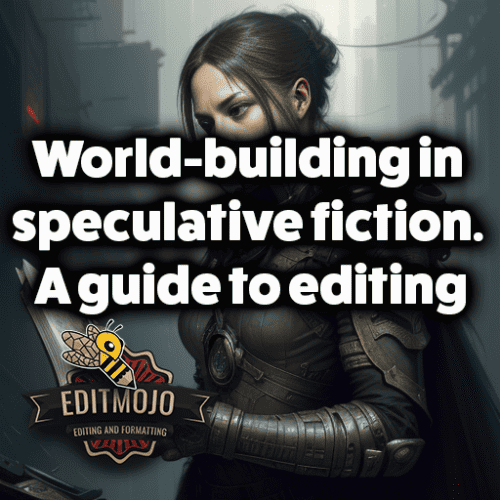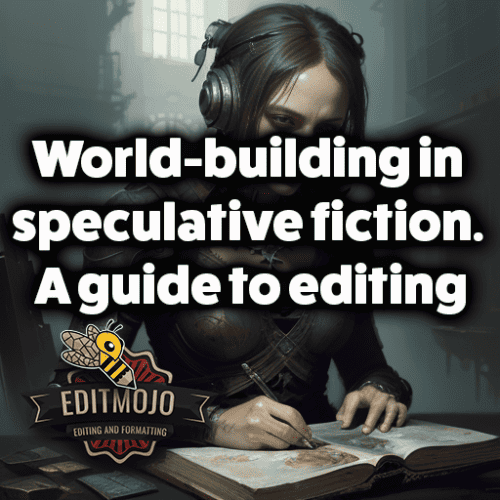World-building in speculative fiction. A guide to editing
World-building in speculative fiction. A guide to editing. World-building, a term often associated with grand narratives, fantastical realms, and captivating universes, forms the beating heart of speculative fiction. Without it, we wouldn’t have the charm of Hogwarts, the dystopian reality of The Hunger Games, or the interstellar societies of Star Trek. But behind the enchanting details and the complexity of these universes lies a process often overlooked: editing. Let’s take a journey through the art and craft of editing world-building in speculative fiction, which allows us to chisel a raw slab of imagination into a finely carved masterpiece.
Key takeaways:
| Key Takeaways |
|---|
| World-building is an essential aspect of speculative fiction, creating immersive and captivating universes. |
| Editing is crucial in ensuring consistency and coherence in world-building, helping to maintain reader immersion. |
| Speculative fiction genres like science fiction, fantasy, and alternative history rely heavily on world-building. |
| Common mistakes in world-building include inconsistencies, lack of detail, and overwhelming exposition. |
| Editing approaches include macro and micro editing, as well as editing for exposition to create a seamless narrative. |
| Seeking feedback and external reviews can provide valuable insights and improve the quality of world-building. |
| Successful world-building examples include George R.R. Martin’s A Song of Ice and Fire and J.K. Rowling’s Harry Potter series. |
| Balancing detail and readability, avoiding info dumps, maintaining suspension of disbelief, and managing complexities are common challenges in editing world-building. |
| Using software tools, books, courses, and workshops can enhance the editing process and improve world-building skills. |
Understanding World-Building in Speculative Fiction
Different Types of Speculative Fiction
Speculative fiction is an umbrella term that encompasses a multitude of genres, including Science Fiction, Fantasy, Supernatural Fiction, and Alternative History. Each genre, while unique in its essence, leverages world-building to immerse the reader into its narrative, from the high-tech civilizations in science fiction to the alternate realities of alternative history.
Role of World-Building in Each Genre
Whether it’s Asimov’s galactic empires or Tolkien’s Middle-Earth, world-building is integral to the charm of speculative fiction. It paints a vivid picture of the setting, crafts relatable or alien characters, and fosters intricate systems of culture, society, politics, and technology or magic. When we examine the concept of world-building closely, it’s evident that it forms the backbone of the narrative, providing a sense of place and depth to the storyline.
Common Elements of World-Building
Successful world-building in speculative fiction tends to revolve around five core elements:
- Setting: The physical world, its layout, geography, climate, flora, fauna, and so on.
- Characters: Their physical characteristics, backgrounds, cultures, beliefs, etc.
- Culture & Society: Social norms, traditions, taboos, arts, religion, etc.
- Politics: The systems of governance, power dynamics, conflicts, alliances, etc.
- Magic Systems or Technologies: The unique tools or powers available within the world, their rules, origins, limitations, etc.

The Need for Editing in World-Building
Common Mistakes in World-Building
In the thrill of crafting entire worlds, it’s easy to make mistakes. Inconsistencies can creep in, details can be overlooked, and logic may be sometimes sacrificed at the altar of creativity. However, these errors, when overlooked, can rupture the very fabric of the narrative, breaking the reader’s immersion. This is where editing steps in as a critical ally.
Significance of Consistency in Speculative Fiction
Speculative fiction often throws the rules of our known universe out the window, presenting the reader with new norms and laws. But even these laws must be consistent. If your protagonist can’t perform magic without a wand at the start, they shouldn’t be suddenly casting spells wand-free by the end, unless there’s a credible explanation. Consistency is the invisible thread that holds the world together, and editing ensures this thread remains unbroken.

The Role of Feedback and Reviews
Feedback and reviews are to editing what cartographers are to explorers. They provide a fresh pair of eyes, spotting inconsistencies and suggesting improvements that may have been missed in the heat of the creative process. In fact, many authors swear by the benefits of alpha and beta readers in the editing process.
Approaches to Editing World-Building
Macro Editing
Macro editing involves looking at the big picture – the overall structure, pacing, and plot progression. This high-level view can help identify overarching issues with the narrative or glaring inconsistencies in the world-building process.
Micro Editing
Micro editing delves into the nitty-gritty, scrutinizing each detail for accuracy and consistency. It may involve checking the rules of your magic system, ensuring the usage of invented languages is correct, or cross-verifying descriptions of locations and characters.
Editing for Exposition
In speculative fiction, authors have to tread a fine line between providing enough information about the world and not overwhelming the reader with an ‘info dump’. The exposition needs to be woven seamlessly into the narrative, and editing plays a crucial role in achieving this balance.

Step-by-Step Guide to Editing World-Building in Speculative Fiction
The process of editing world-building elements can be daunting. Here’s a step-by-step guide to make it manageable and effective:
First Reading: Spotting Glaring Inconsistencies
In the initial read-through, focus on identifying glaring inconsistencies, confusing narrative arcs, and plot holes. These high-level issues need to be addressed before focusing on the details.
Second Reading: Detailed Examination of Each World-Building Element
For each of the five core elements of world-building:
- Setting: Ensure your descriptions are consistent, your geography makes sense, and the climate and ecosystem align with the world’s rules.
- Characters: Validate character backgrounds, motivations, and actions within the context of the world.
- Culture & Society: Check that social norms, traditions, and societal structures work cohesively with the setting and characters.
- Politics: Assess the logic and consistency of political structures and power dynamics.
- Magic Systems or Technologies: Scrutinize the functionality, limitations, and rules of these systems.
Third Reading: Streamlining Exposition and Maintaining Interest
During the third reading, pay special attention to the pacing of the story and the integration of world-building details into the narrative. Ensure that exposition feels natural, rather than a tedious lecture.
Seeking External Reviews
Having others review your work can offer valuable insights that might be missed when you’re too close to your project. Consider using platforms like Scribophile or Critique Circle for objective critiques.
Final Review: Polishing for Publication
The final review is a last sweep for grammar, spelling, punctuation, and minor details. By now, your world should be finely crafted, consistent, and compelling.
Case Studies: Successful World-Building in Speculative Fiction
George R.R. Martin’s A Song of Ice and Fire series offers a perfect case study in world-building. The world of Westeros and Essos feels real because of its depth and consistency. The social, political, and cultural dynamics are complex and intertwined, making the world seem lived-in and tangible.
Another prime example is J.K. Rowling’s Harry Potter series, which presents a world that operates by its own set of consistent laws, yet is engaging and immersive. The wizarding world feels concrete because of Rowling’s meticulous attention to detail, down to the peculiar properties of various magical plants.
Tools and Resources for Editing World-Building
Leveraging the right tools and resources can greatly streamline the editing process:
- Software: Tools like Scrivener or Google Docs can be extremely helpful for organizing your work and making edits.
- Books: Titles such as “Wonderbook: The Illustrated Guide to Creating Imaginative Fiction” by Jeff VanderMeer offers valuable insights on world-building.
- Courses: MasterClass, Coursera, and Udemy offer courses on world-building and writing speculative fiction.
Common Pitfalls and Challenges in Editing World-Building
Balancing Detail and Readability
While details enrich the world, too many can bog down the narrative. Striking a balance between immersive world-building and maintaining pace and readability is one of the key challenges in editing.
Avoiding Info Dumps
Resist the urge to expound all details about your world at once. Information should be woven subtly into the narrative. “Show, don’t tell” is a golden rule to remember.
Maintaining the Suspension of Disbelief
In speculative fiction, the reader willingly suspends disbelief. However, inconsistencies in world-building can shatter this fragile contract, pulling the reader out of the story. Maintaining this suspension of disbelief is paramount.
Dealing with Complexities in World-Building
Editing world-building in speculative fiction can be a complex task, with multiple interconnected elements to keep track of. Having a structured approach to editing can help manage these complexities.
Conclusion (World-building in speculative fiction. A guide to editing)
World-building is an enchanting, yet challenging aspect of speculative fiction. It gives depth to the narrative, providing a concrete stage for the characters to interact with and the plot to unfold. And the process that polishes this rough diamond into a brilliant gem is editing. It may seem daunting, yet it’s an immensely rewarding and enriching process. With every edit, the world becomes a bit more immersive, a bit more consistent, and a lot more captivating. As speculative fiction writers, that’s the enchantment we strive to create, one edit at a time.
References (World-building in speculative fiction. A guide to editing)
For further reading on the topic, consider these resources:
- “Building Imaginary Worlds: The Theory and History of Subcreation” by Mark J.P. Wolf
- “The Art of Language Invention: From Horse-Lords to Dark Elves, the Words Behind World-Building” by David J. Peterson
- Wikipedia: World Building
- World Building Institute
And here’s a table with the top five questions and answers related to world-building in speculative fiction:
| Questions | Answers |
|---|---|
| What is world-building? | World-building is the process of creating detailed and immersive fictional worlds within speculative fiction genres like science fiction, fantasy, and alternative history. |
| Why is editing important in world-building? | Editing ensures consistency, coherence, and realism in the created world, enhancing reader immersion and engagement. It helps identify and fix inconsistencies, improve pacing, and streamline exposition. |
| What are some common mistakes in world-building? | Common mistakes include inconsistencies in rules or details, overwhelming exposition or info dumps, lack of depth or detail, and disregarding the logic of the established world. |
| How can I edit world-building effectively? | Effective editing involves multiple readings, focusing on macro and micro elements, streamlining exposition, seeking feedback from others, and conducting final reviews for grammar and polish. |
| What resources can I use to improve world-building and editing skills? | Resources like software tools (e.g., Scrivener, Google Docs), books on writing and world-building, online courses (e.g., MasterClass, Coursera, Udemy), and workshops can be valuable for improving world-building and editing techniques. |
